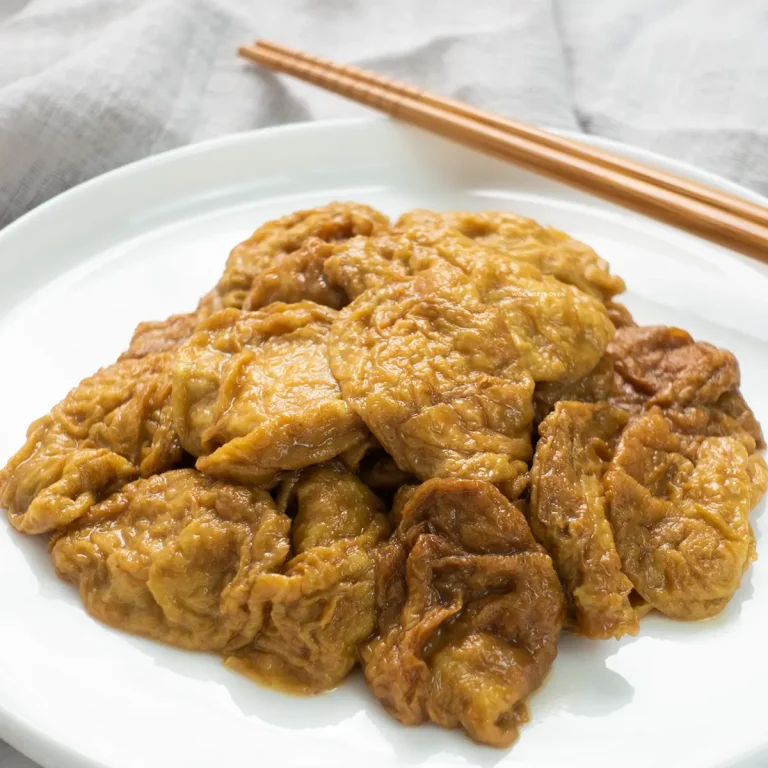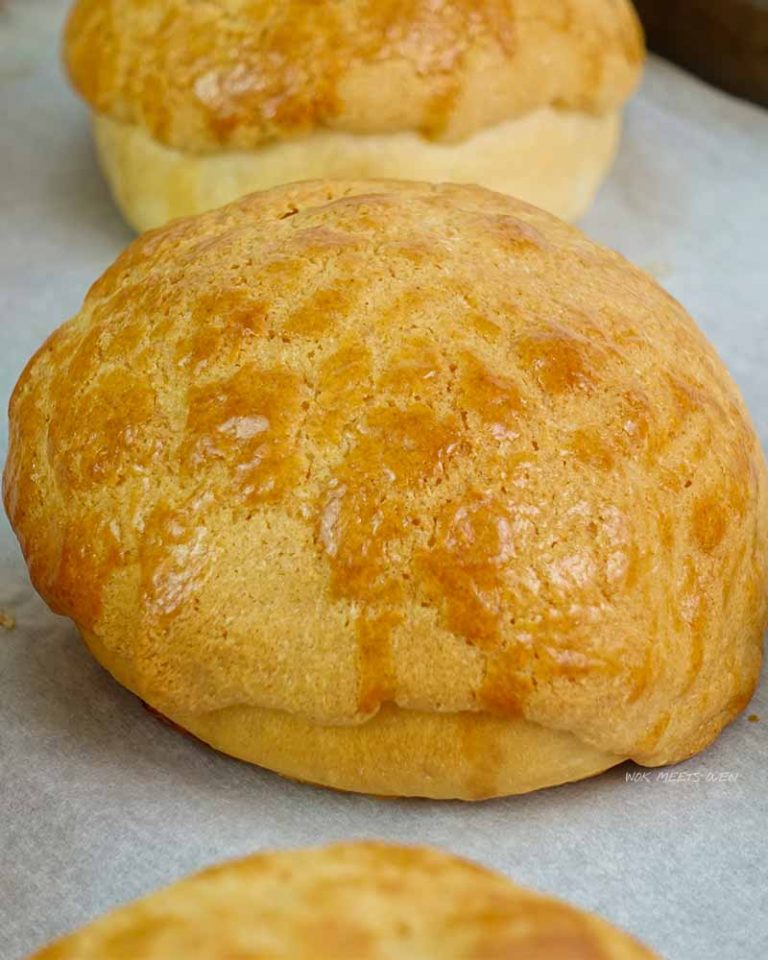Homemade Lotus Seed Paste Recipe
Smooth, fragrant, but not overly sweet — this homemade lotus seed paste is the signature filling for making traditional lotus seed paste mooncakes. Learn how to make this iconic lotus paste filling from scratch at home.

What Is Lotus Seed Paste?
If you’ve ever eaten a traditional baked mooncake before, then there’s a good chance that you’ve eaten lotus seed paste mooncakes.
Lotus seed paste is like the yin to the yang of mooncakes. They both go hand in hand, along with salted egg yolks.
But it doesn’t just stop at traditional moon cakes. You’ll also see it being present in Shanghai-style mooncakes (上海月餅), steamed buns (蓮蓉包), lotus seed milk bread buns, and puff pastries (蛋黄蓮蓉酥).
Lotus seed paste (白 蓮蓉 餡) is a creamy and rich Chinese filling made using lotus seeds. You’ll typically see either white or red lotus seeds being used to produce the filling.
A salted egg yolk or two is then wrapped inside the lotus seed filling and stuffed inside the skin of a mooncake to create the iconic baked mooncakes that we’ve all grown to love. If you’d like to learn how to make mooncakes, then check out my lotus seed paste mooncake recipe.
The process for making homemade lotus paste is pretty straightforward:
Lotus seeds are first soaked overnight to soften them up and then cooked. This process further makes them even softer.
The seeds are then ground down and combined with additional ingredients such as sugar, cooking oil, and maltose before finally being cooked until they turn into a smooth paste.
As you can imagine, this process is very time-consuming, which likely contributes to the high cost of production, not to mention lotus seeds themselves being quite pricey.
That’s why a lot of manufacturers cut corners by introducing additional ingredients such as white beans to save costs at the expense of producing an inferior-tasting paste.
Luckily, though, the process of making lotus seed paste is pretty straightforward, albeit time-consuming.
Once you master how to make your own homemade lotus seed paste filling, you’ll never want to buy store-made lotus seed paste again!
In this article, I’ll show you step-by-step how to make lotus seed paste for mooncakes, but you can use it for other baked goods as well.
Where to Buy Lotus Seeds?
Dried lotus seeds are typically sold at Asian grocery stores, especially Chinese grocery stores. Sometimes you might even find them being sold at Chinese herbal shops as well.
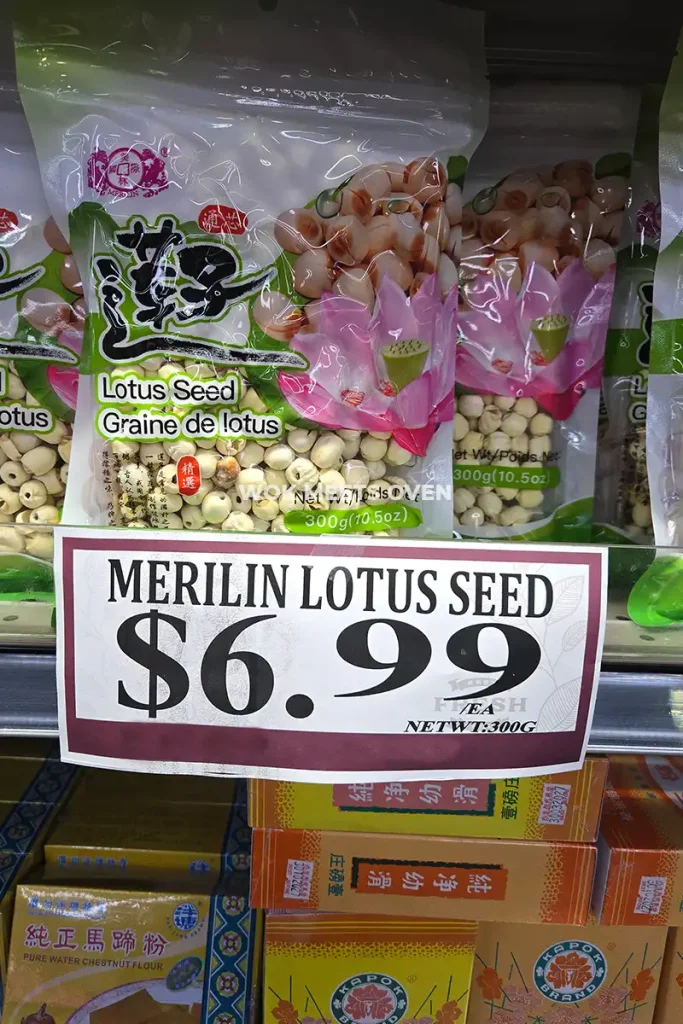
Now let’s discuss some of the most important ingredients that you’ll be using in this white lotus seed paste recipe.
Ingredient Notes

White lotus seeds: This is the most common kind of lotus seeds that you’ll find being sold at Asian grocery stores (at least where I’m from). The lotus seeds will typically be dried and need to be soaked overnight to soften them up before boiling them. There are also red lotus seeds that you may find at Asian grocery stores that you can substitute for the white ones.

Maltose: Maltose is easily found at most Asian grocery stores. This syrup is sweet and very sticky and is typically added to the filling. It sort of resembles honey but with a much thicker consistency.

Substitutions
- White lotus seeds: You can substitute them with red lotus seeds.
- Maltose: You can substitute it with honey (but it will taste slightly different)
- Vegetable oil: You can substitute it with peanut oil or lard. Do not use olive oil!
How to Make Lotus Seed Paste
- In a large bowl, add in your dried lotus seeds, and then fill the bowl with enough water to cover all of the lotus seeds plus an extra 2 inches above the lotus seeds.
- Allow the lotus seeds to soak overnight in the fridge.
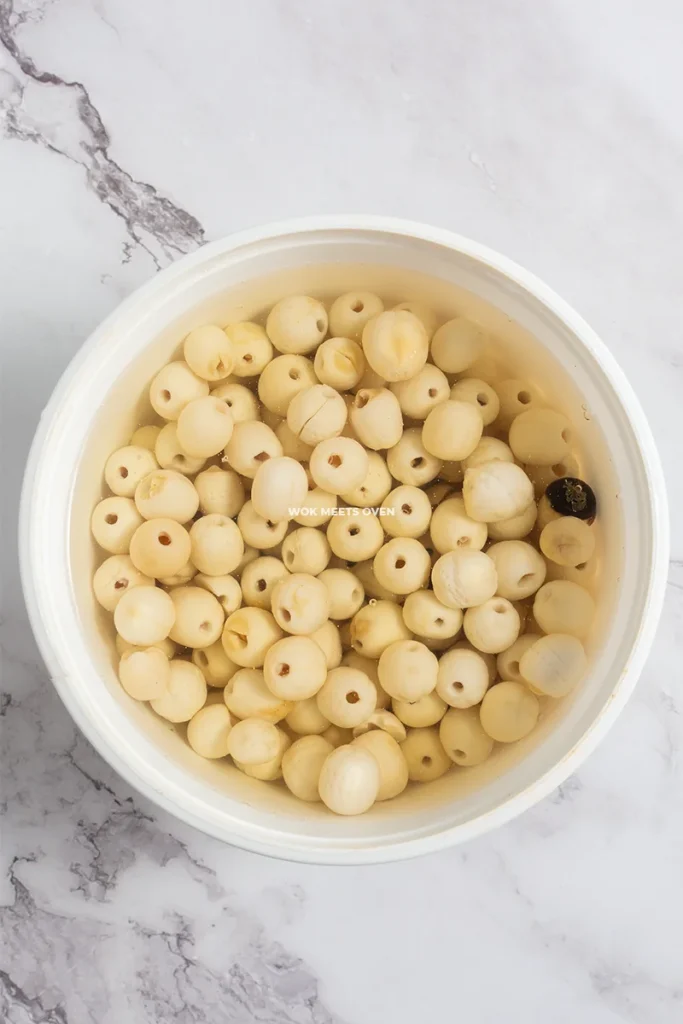

- The next day, strain out all of the water and give the lotus seeds a quick rinse.
- Now open the lotus seeds and take out the green stem in the core if you see any. If you don’t remove the green stems, they will make your lotus seed paste very bitter. You can save these green stem cores for brewing tea if you’d like.


- Once done, give the lotus seeds another quick rinse and then add them to a pot with water. Boil the lotus seeds on medium heat in the pot until there is about 1/2 inch of water above the lotus seeds. Now turn down the heat to medium-low/ low-heat and continue cooking the lotus seeds until they become soft. This will take a while, so be prepared. It took me about an 1 hour to cook the lotus seeds over the stove.

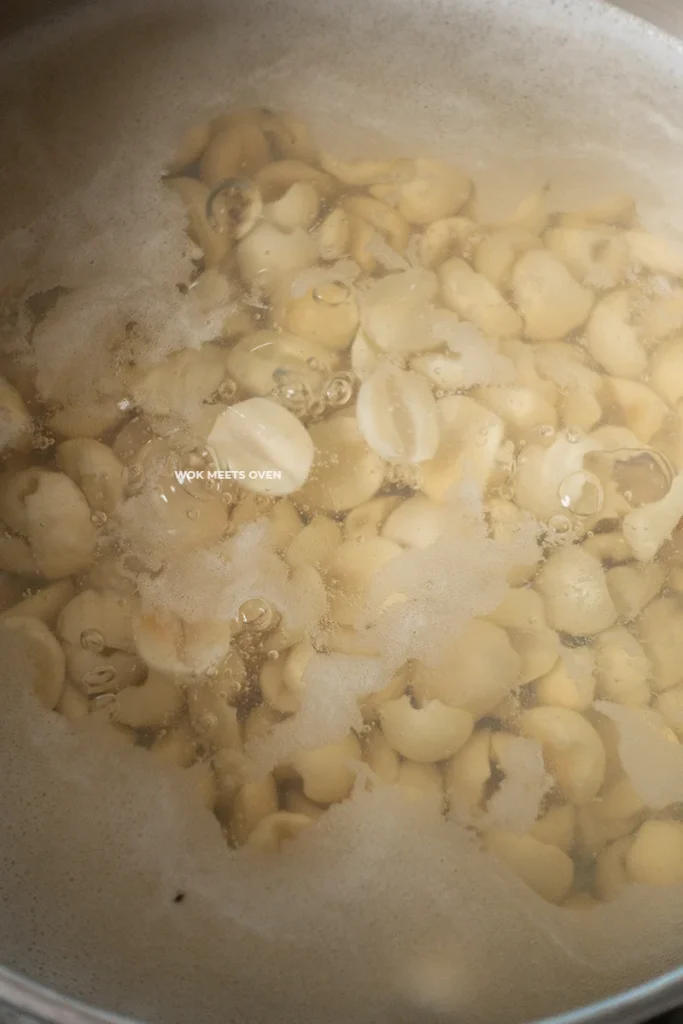
- To check when the lotus seeds are ready, scoop up 1-2 lotus seeds and press down on them with your finger. The lotus seed should easily break and become mushy if it has reached the right softness level.
- Once done, remove the pot from the stove and allow it to cool down.
- Now transfer all of the contents of the pot, including the leftover water to a blender.
- Blend everything together until the lotus seeds become a smooth paste. If you find the lotus paste too thick, then add an additional 1-2 Tablespoons of water to the blender and continue blending it until nice and smooth. It should have a consistency similar to peanut butter.
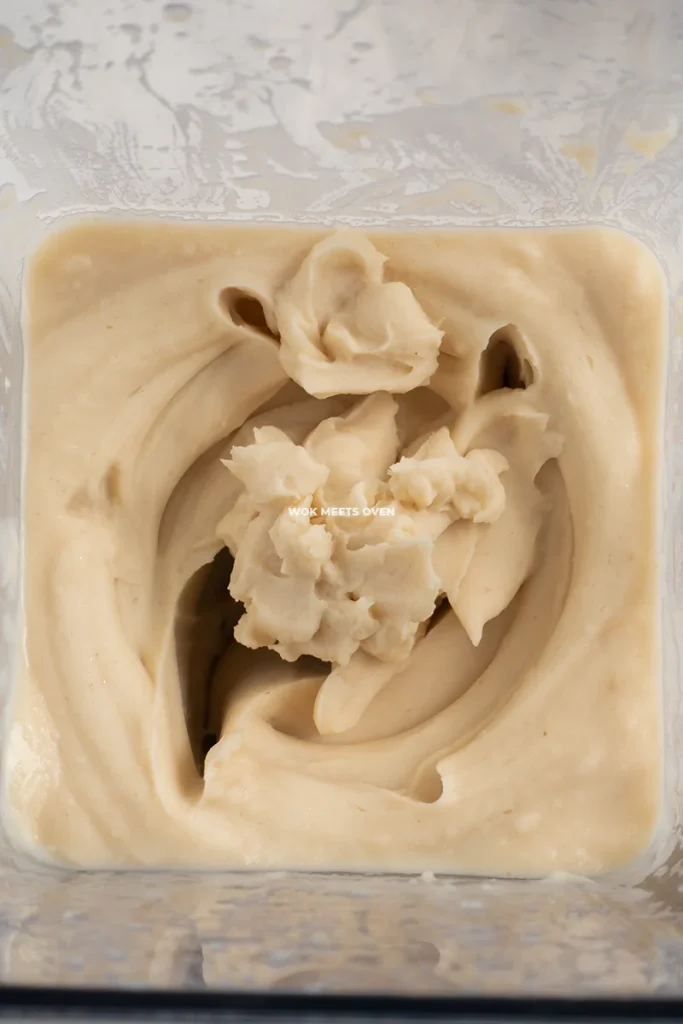
- Once done, transfer the contents into a bowl and set the lotus paste aside.
- Now, add 3 tablespoons of cooking oil along with your white sugar to a non-stick pan and cook it over medium-low heat while constantly stirring the pan. Continue cooking the mixture until all of the sugar has melted and caramelized. You should have a nice brown color syrup in the pan.
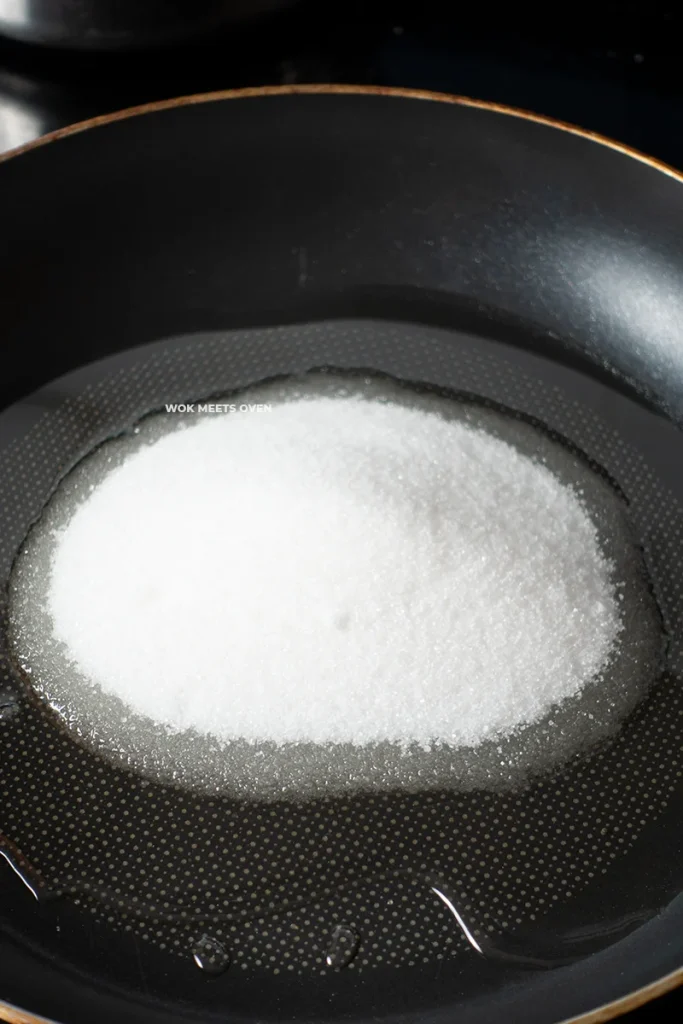
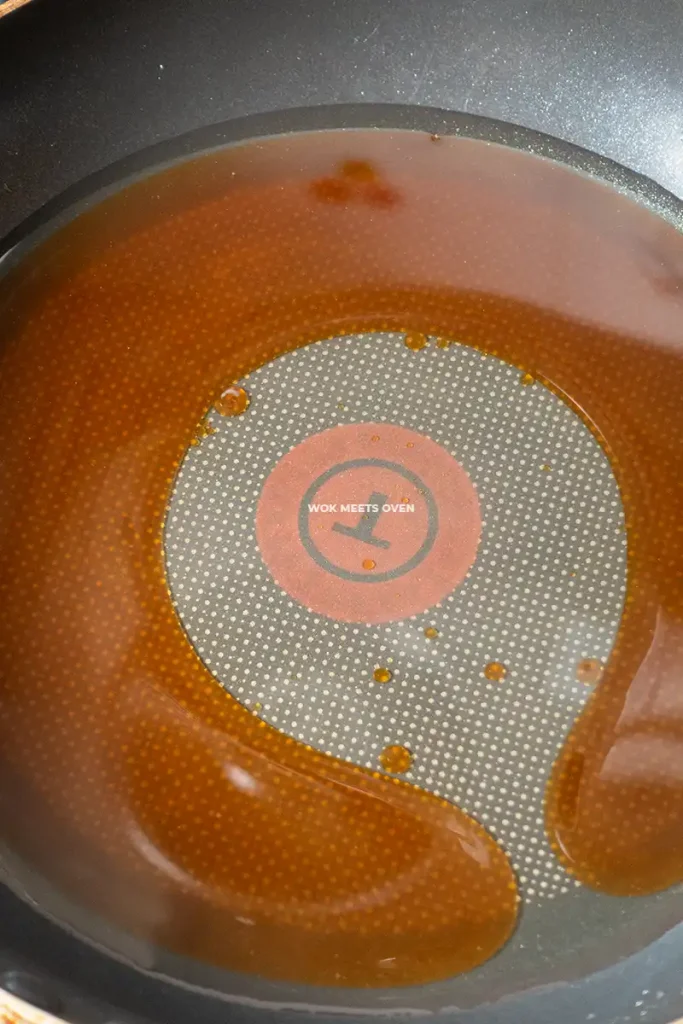
- Now, add your blended lotus paste to the pan and mix everything well together with the oil and caramelized sugar.
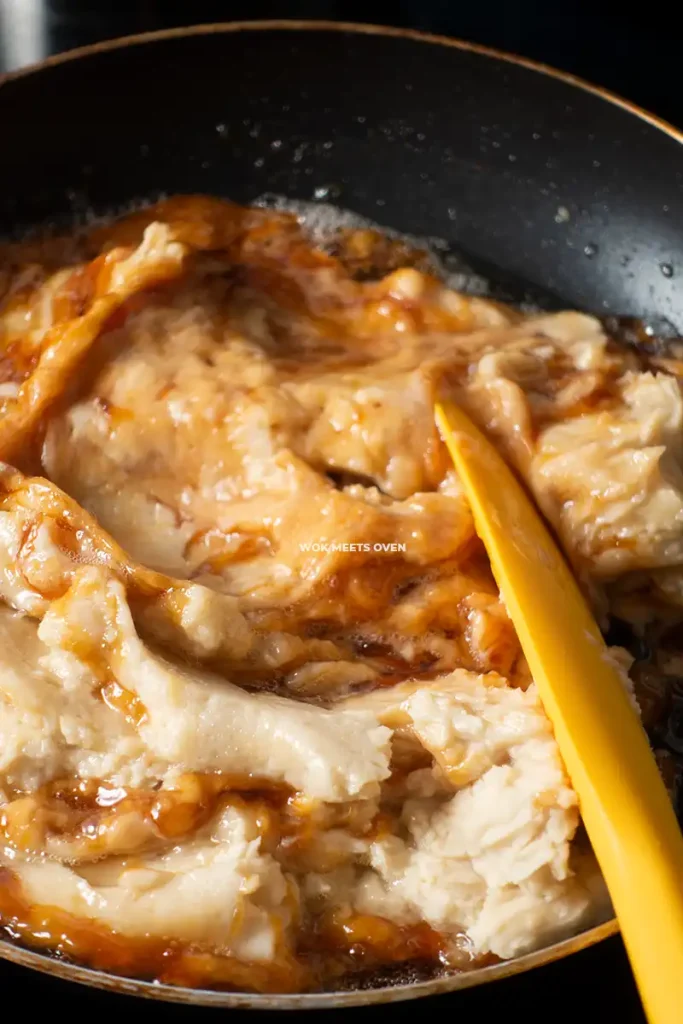
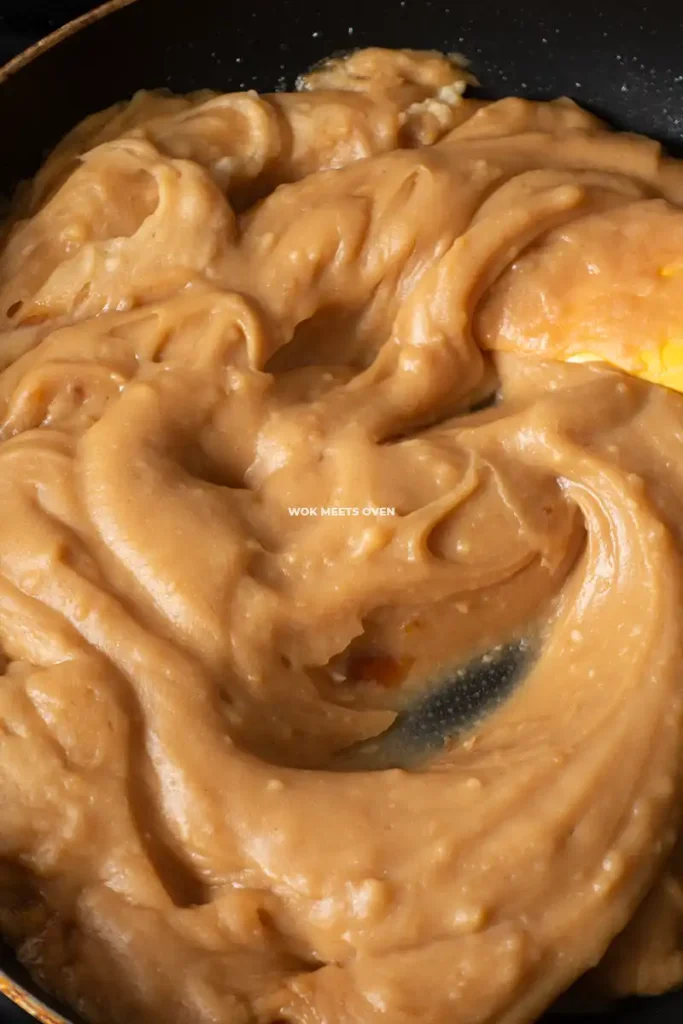
- Next, add in your leftover cooking oil in 3 stages. Add about a 1/3 of it into the pan and mix it well together with the lotus paste. Once all of the oil has been absorbed, add in another 1/3 of it and mix it well with the lotus paste until all of it has been absorbed. Then, add in the remaining 1/3 of oil and repeat the process.
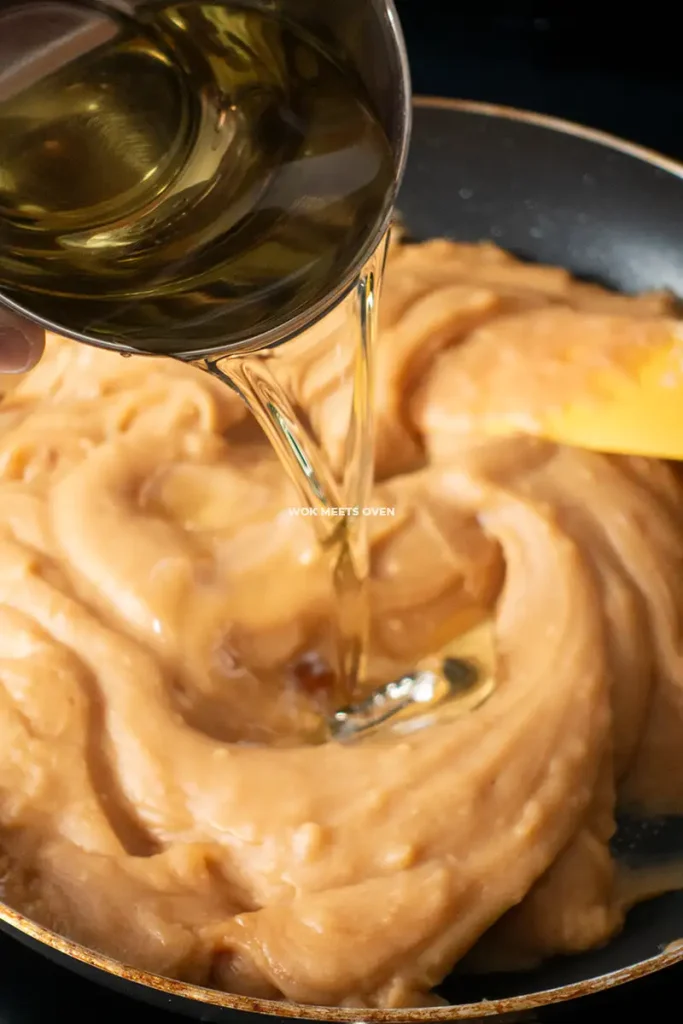
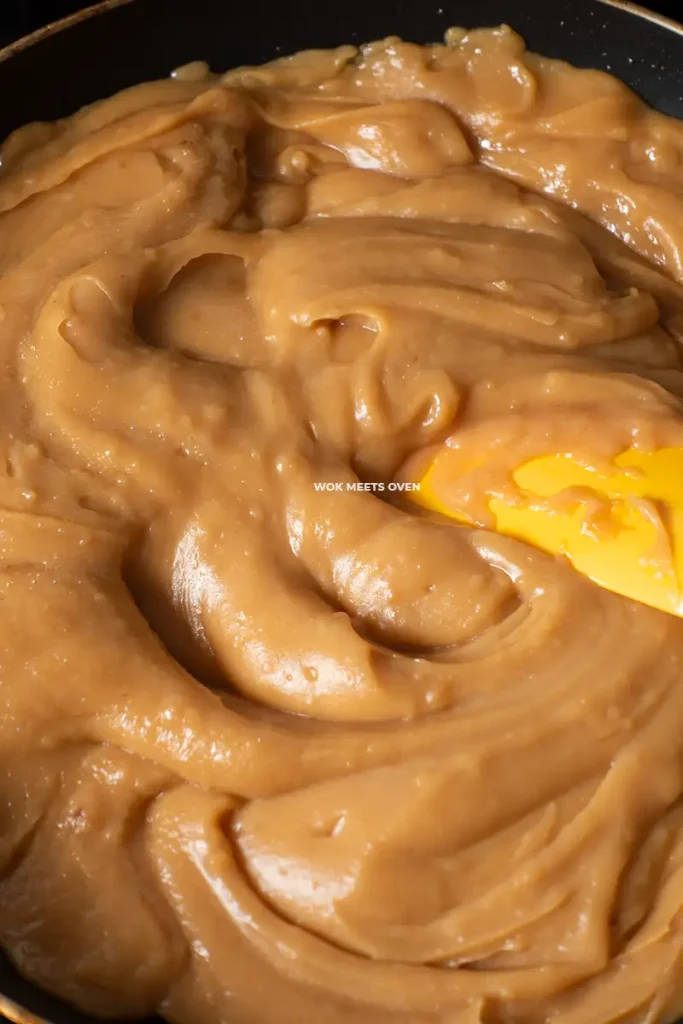
- Once all of the oil has been absorbed by the lotus paste, add in your maltose and mix everything well together.

- Continue cooking this mixture over medium-low heat until most of the water has evaporated and the lotus paste doesn’t stick to your spatula or pan anymore. It should resemble one large piece of filling. Do not overcook the filling, or it will become dry!!!
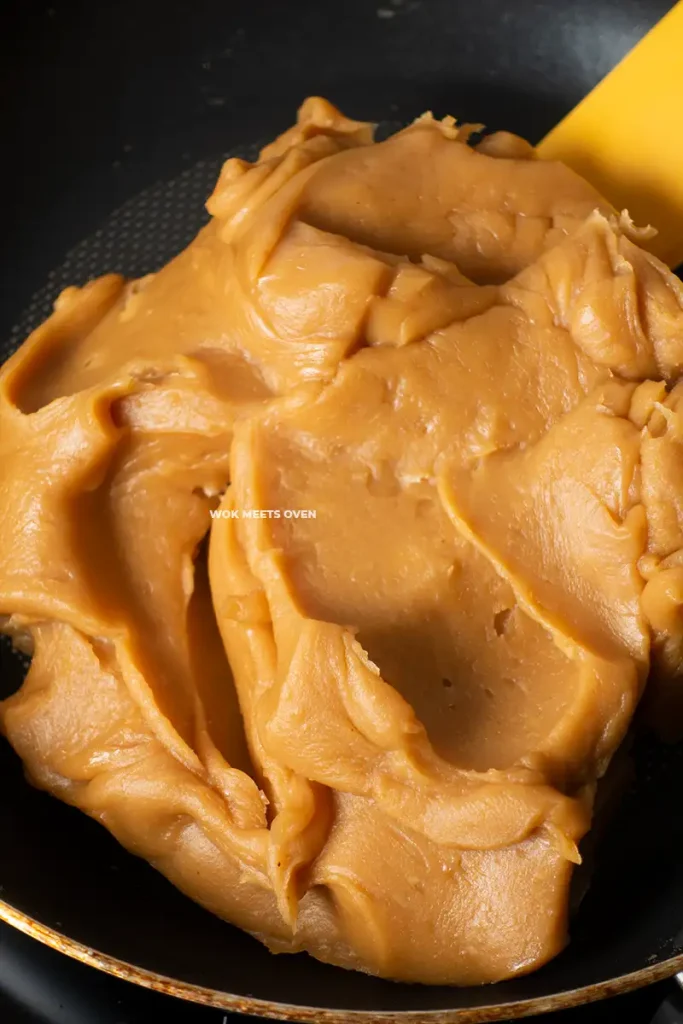
- Remove the filling from the stove and pour it into a bowl or container.
- Let it cool down, and then cover it with plastic wrap and place it in the fridge to chill.
- The lotus seed paste is now ready to use.
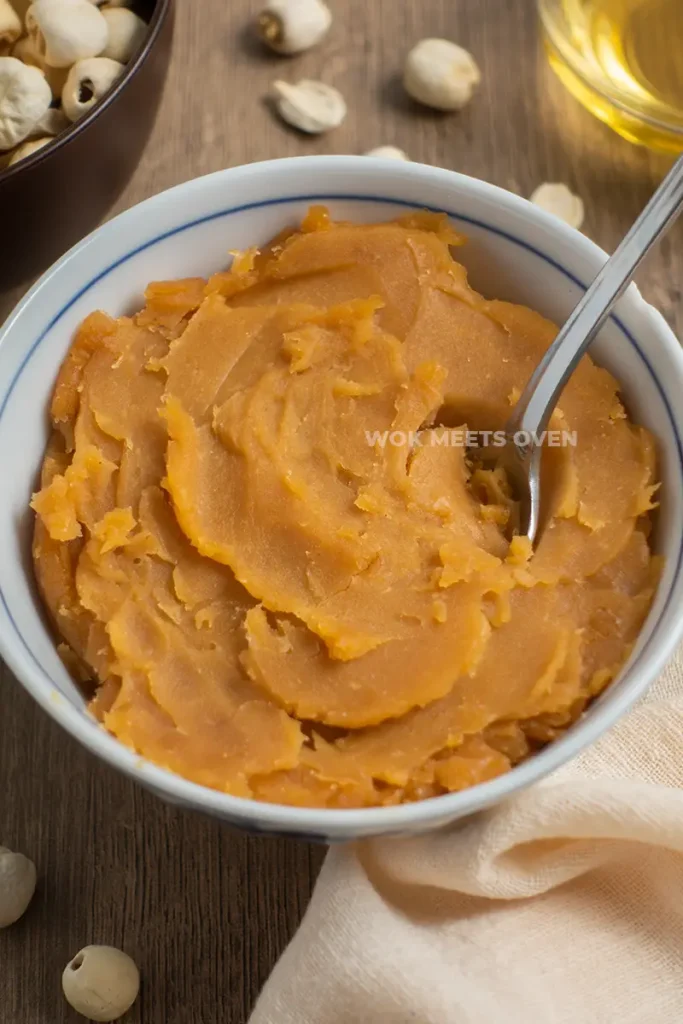
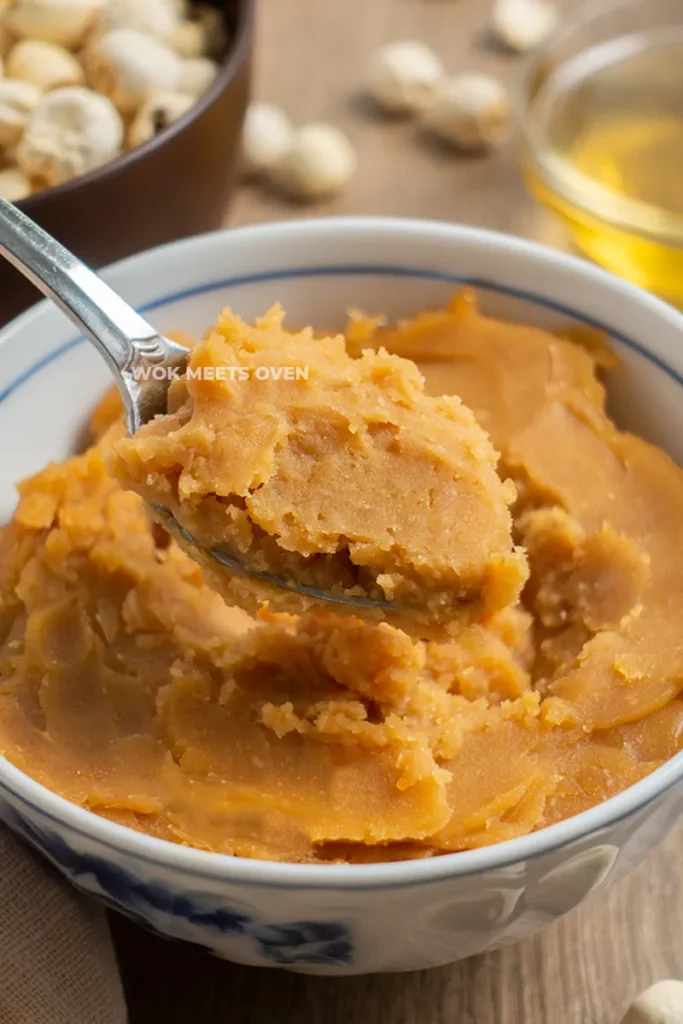
A Few Helpful Tips
Common Mistakes Beginners Make
- Not allowing the lotus seed paste to cook long enough over the pan. This results in a sticky and runny filling.
- Not cooking the lotus seeds long enough in the pot. This results in a hard crunchy filling.
- Trying to convert measurements into cups (US customary). You need a kitchen scale!
Storage Tips
The lotus seed paste can be stored in the fridge either wrapped in plastic wrap or an airtight container for up to a week.
Recipes That Go Well With This Recipe
Lotus seed paste is typically used as a filling when making lotus seed paste salted egg yolk mooncakes. It can also be used as filling for other milk bread buns or Chinese pastries as well.
Frequently Asked Questions (FAQs)
How Long Should I Soak My Lotus Seeds?
You’ll want to soak them ideally overnight in the fridge or a minimum of 10-12 hours.
How Long Should I Cook the Lotus Seeds?
This will depend on your stove, pot used, and how high the heat is, but basically, you want to cook the lotus seeds up to the point where you can gently press down on them and they will easily break apart and turn into mush. This usually happens right around the time when there is a tiny bit of water left in the pot and you can clearly see the lotus seeds.
For me personally, it took a little over an hour to get to that point, but it might be different for you.
Why Is My Lotus Seed Paste Filling Not Firming Up?
You’re not cooking it long enough. You need to continue cooking it to evaporate more of the liquid and allow the lotus seed paste to soak up more of the oil. It will take a while, be prepared for this!
Why Is My Filling Too Sticky?
There’s still too much liquid in it. You need to cook it longer until it resembles one large piece of filling and doesn’t stick to your spatula.
Can I Use a Pressure Cooker to Cook the Lotus Seeds?
Yes!
How Much Lotus Paste Filling Will I Get From This Recipe?
You’ll get approximately 650g of lotus seed paste filling from this recipe. The amount of water you have left after boiling the lotus seeds and how much is blended in with the lotus seed paste will determine the final amount.
You can pin this image
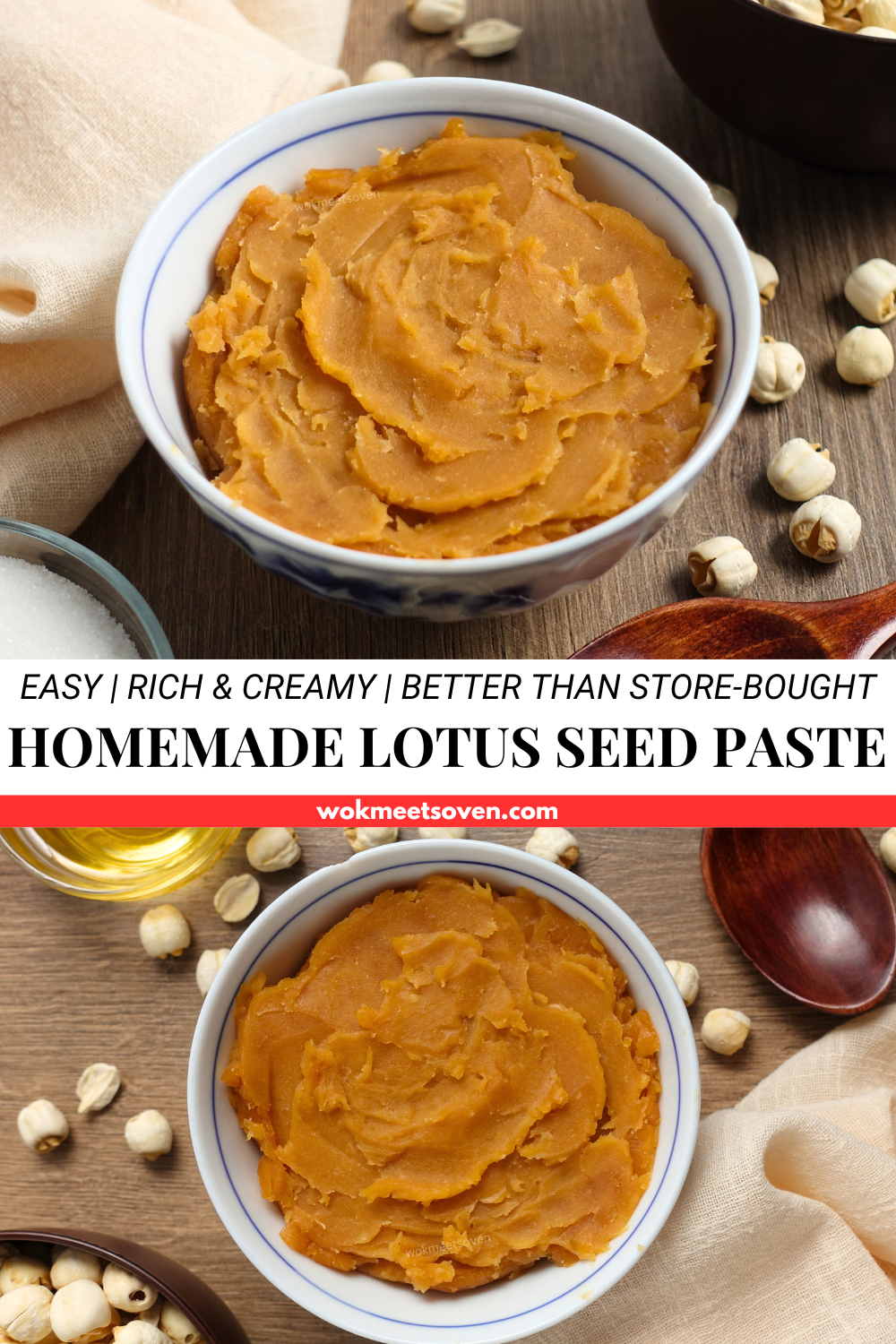
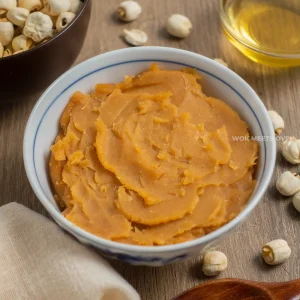
Homemade Lotus Seed Paste Recipe
Equipment
- 1 Pot
- 1 Non-stick Pan
Ingredients
- 185 g White Lotus Seeds
- 125 g White Granulated Sugar
- 865 ml Water
- 50 g Maltose
- 175 g Vegetable Oil
Instructions
- In a large bowl, add in your dried lotus seeds, and then fill the bowl with enough water to cover all of the lotus seeds plus an extra 2 inches above the lotus seeds.
- Allow the lotus seeds to soak overnight in the fridge.
- The next day, strain out all of the water and give the lotus seeds a quick rinse.
- Now open the lotus seeds and take out the green stem in the core if you see any. If you don’t remove the green stems, they will make your lotus seed paste very bitter. You can save these green stem cores for brewing tea if you’d like.
- Once done, give the lotus seeds another quick rinse and then add them to a pot with water. Boil the lotus seeds on medium heat in the pot until there is about 1/2 inch of water above the lotus seeds. Now turn down the heat to medium-low/ low-heat and continue cooking the lotus seeds until they become soft. This will take a while, so be prepared. It took me about an 1 hour to cook the lotus seeds over the stove.
- To check when the lotus seeds are ready, scoop up 1-2 lotus seeds and press down on them with your finger. The lotus seed should easily break and become mushy if it has reached the right softness level.
- Once done, remove the pot from the stove and allow it to cool down.
- Now transfer all of the contents of the pot, including the leftover water to a blender.
- Blend everything together until the lotus seeds become a smooth paste. If you find the lotus paste too thick, then add an additional 1-2 Tablespoons of water to the blender and continue blending it until nice and smooth. It should have a consistency similar to peanut butter.
- Once done, transfer the contents into a bowl and set the lotus paste aside.
- Now, add 3 tablespoons of cooking oil along with your white sugar to a non-stick pan and cook it over medium-low heat while constantly stirring the pan. Continue cooking the mixture until all of the sugar has melted and caramelized. You should have a nice brown color syrup in the pan.
- Now, add your blended lotus paste to the pan and mix everything well together with the oil and caramelized sugar.
- Next, add in your leftover cooking oil in 3 stages. Add about a 1/3 of it into the pan and mix it well together with the lotus paste. Once all of the oil has been absorbed, add in another 1/3 of it and mix it well with the lotus paste until all of it has been absorbed. Then, add in the remaining 1/3 of oil and repeat the process.
- Once all of the oil has been absorbed by the lotus paste, add in your maltose and mix everything well together.
- Continue cooking this mixture over medium-low heat until most of the water has evaporated and the lotus paste doesn’t stick to your spatula or pan anymore. It should resemble one large piece of filling. Do not overcook the filling, or it will become dry!!!
- Remove the filling from the stove and pour it into a bowl or container.
- Let it cool down, and then cover it with plastic wrap and place it in the fridge to chill.
- The lotus seed paste is now ready to use.





